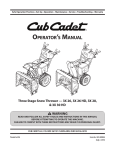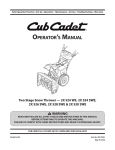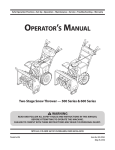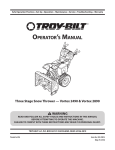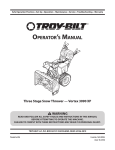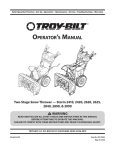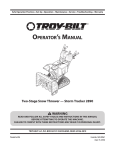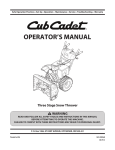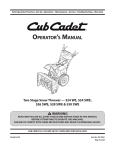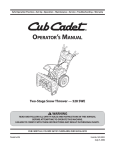Download Cub Cadet CC 30 Operator`s manual
Transcript
Safe Operation Practices • Set-Up • Operation • Maintenance • Service • Troubleshooting • Warranty Operator’s Manual Three-Stage Snow Thrower — 3X 30” TRAC WARNING READ AND FOLLOW ALL SAFETY RULES AND INSTRUCTIONS IN THIS MANUAL BEFORE ATTEMPTING TO OPERATE THIS MACHINE. FAILURE TO COMPLY WITH THESE INSTRUCTIONS MAY RESULT IN PERSONAL INJURY. CUB CADET LLC, P.O. BOX 361131 CLEVELAND, OHIO 44136-0019 Printed In USA Form No. 769-09945 (June 5, 2014) 1 To The Owner Thank You Thank you for purchasing a Cub Cadet 3X Snow Thrower. It was carefully engineered to provide excellent performance when properly operated and maintained. Please read this entire manual prior to operating the equipment. It instructs you how to safely and easily set up, operate and maintain your machine. Please be sure that you, and any other persons who will operate the machine, carefully follow the recommended safety practices at all times. Failure to do so could result in personal injury or property damage. All information in this manual is relative to the most recent product information available at the time of printing. Review this manual frequently to familiarize yourself with the machine, its features and operation. Please be aware that this Operator’s Manual may cover a range of product specifications for various models. Characteristics and features discussed and/or illustrated in this manual may not be applicable to all models. Table of Contents We reserve the right to change product specifications, designs and equipment without notice and without incurring obligation. If applicable, the power testing information used to establish the power rating of the engine equipped on this machine can be found at www.opei.org or the engine manufacturer’s web site. If you have any problems or questions concerning the machine, phone your local Cub Cadet dealer or contact us directly. Cub Cadet’s Customer Support telephone numbers, website address and mailing address can be found on this page. We want to ensure your complete satisfaction at all times. Throughout this manual, all references to right and left side of the machine are observed from the operating position. Safe Operation Practices......................................... 3 Assembly & Set-Up................................................... 7 Controls....................................................................11 Operation.................................................................14 Maintenance & Adjustments.................................15 Service......................................................................19 Troubleshooting......................................................21 Replacement Parts................................................. 22 Attachments & Accessories................................... 23 Warranty...................................................Back Cover Record Product Information Model Number Before setting up and operating your new equipment, please locate the model plate on the equipment and record the information in the provided area to the right. You can locate the model plate by standing at the operator’s position and looking down at the rear of the frame. This information will be necessary, should you seek technical support via our web site or with your local Cub Cadet dealer. Serial Number Product Registration and Customer Support Please register your product on our website, www.cubcadet.com. If you have difficulty assembling this product or have any questions regarding the controls, operation, or maintenance of this machine, you can seek help from the experts. Choose from the options below: ◊ Visit us on the web at www.cubcadet.com See How-to Maintenance and Parts Installation Videos at www.cubcadet.com/tutorials 2 ◊ Locate your nearest Cub Cadet Dealer at (877) 282-8684 ◊ Write to Cub Cadet LLC • P.O. Box 361131 • Cleveland, OH • 44136-0019 Important Safe Operation Practices 2 WARNING! This symbol points out important safety instructions which, if not followed, could endanger the personal safety and/or property of yourself and others. Read and follow all instructions in this manual before attempting to operate this machine. Failure to comply with these instructions may result in personal injury. When you see this symbol. HEED ITS WARNING! CALIFORNIA PROPOSITION 65 WARNING! Engine Exhaust, some of its constituents, and certain vehicle components contain or emit chemicals known to State of California to cause cancer and birth defects or other reproductive harm. DANGER: This machine was built to be operated according to the safe operation practices in this manual. As with any type of power equipment, carelessness or error on the part of the operator can result in serious injury. This machine is capable of amputating fingers, hands, toes and feet and throwing foreign objects. Failure to observe the following safety instructions could result in serious injury or death. Training Preparation 1. Read, understand, and follow all instructions on the machine and in the manual(s) before attempting to assemble and operate. Keep this manual in a safe place for future and regular reference and for ordering replacement parts. Thoroughly inspect the area where the equipment is to be used. Remove all doormats, newspapers, sleds, boards, wires and other foreign objects, which could be tripped over or thrown by the auger/impeller. 2. Be familiar with all controls and their proper operation. Know how to stop the machine and disengage them quickly. 3. 1. Always wear safety glasses or eye shields during operation and while performing an adjustment or repair to protect your eyes. Thrown objects which ricochet can cause serious injury to the eyes. Never allow children under 14 years of age to operate this machine. Children 14 and over should read and understand the instructions and safe operation practices in this manual and on the machine and be trained and supervised by an adult. 2. Do not operate without wearing adequate winter outer garments. Do not wear jewelry, long scarves or other loose clothing, which could become entangled in moving parts. Wear footwear which will improve footing on slippery surfaces. 4. Never allow adults to operate this machine without proper instruction. 3. Use a grounded three-wire extension cord and receptacle for all machines with electric start engines. 5. Thrown objects can cause serious personal injury. Plan your snow-throwing pattern to avoid discharge of material toward roads, bystanders and the like. 4. Adjust auger housing height to clear gravel or crushed rock surfaces. 6. Keep bystanders, pets and children at least 75 feet from the machine while it is in operation. Stop machine if anyone enters the area. 5. Disengage all control levers before starting the engine. 6. 7. Exercise caution to avoid slipping or falling, especially when operating in reverse. Never attempt to make any adjustments while engine is running, except where specifically recommended in the operator’s manual. 7. Let engine and machine adjust to outdoor temperature before starting to clear snow. 3 Safe Handling of Gasoline 5. To avoid personal injury or property damage use extreme care in handling gasoline. Gasoline is extremely flammable and the vapors are explosive. Serious personal injury can occur when gasoline is spilled on yourself or your clothes which can ignite. Wash your skin and change clothes immediately. Never run an engine indoors or in a poorly ventilated area. Engine exhaust contains carbon monoxide, an odorless and deadly gas. 6. Do not operate machine while under the influence of alcohol or drugs. 7. Muffler and engine become hot and can cause a burn. Do not touch. Keep children away. a. Use only an approved gasoline container. b. Extinguish all cigarettes, cigars, pipes and other sources of ignition. 8. Exercise extreme caution when operating on or crossing gravel surfaces. Stay alert for hidden hazards or traffic. c. Never fuel machine indoors. 9. d. Never remove gas cap or add fuel while the engine is hot or running. Exercise caution when changing direction and while operating on slopes. Do not operate on steep slopes. 10. e. Allow engine to cool at least two minutes before refueling. Plan your snow-throwing pattern to avoid discharge towards windows, walls, cars etc. Thus, avoiding possible property damage or personal injury caused by a ricochet. f. Never over fill fuel tank. Fill tank to no more than ½ inch below bottom of filler neck to provide space for fuel expansion. 11. Never direct discharge at children, bystanders and pets or allow anyone in front of the machine. g. Replace gasoline cap and tighten securely. h. If gasoline is spilled, wipe it off the engine and equipment. Move machine to another area. Wait 5 minutes before starting the engine. i. Never store the machine or fuel container inside where there is an open flame, spark or pilot light (e.g. furnace, water heater, space heater, clothes dryer etc.). j. Allow machine to cool at least 5 minutes before storing. k. Never fill containers inside a vehicle or on a truck or trailer bed with a plastic liner. Always place containers on the ground away from your vehicle before filling. l. If possible, remove gas-powered equipment from the truck or trailer and refuel it on the ground. If this is not possible, then refuel such equipment on a trailer with a portable container, rather than from a gasoline dispenser nozzle. m. Keep the nozzle in contact with the rim of the fuel tank or container opening at all times until fueling is complete. Do not use a nozzle lock-open device. Operation 1. 4 Do not put hands or feet near rotating parts, in the auger/ impeller housing or chute assembly. Contact with the rotating parts can amputate hands and feet. 2. The auger/impeller control lever is a safety device. Never bypass its operation. Doing so makes the machine unsafe and may cause personal injury. 3. The control levers must operate easily in both directions and automatically return to the disengaged position when released. 4. Never operate with a missing or damaged chute assembly. Keep all safety devices in place and working. Section 2 — Important Safe Operation Practices 12. Do not overload machine capacity by attempting to clear snow at too fast of a rate. 13. Never operate this machine without good visibility or light. Always be sure of your footing and keep a firm hold on the handles. Walk, never run. 14. Disengage power to the auger/impeller when transporting or not in use. 15. Never operate machine at high transport speeds on slippery surfaces. Look down and behind and use care when backing up. 16. If the machine should start to vibrate abnormally, stop the engine, disconnect the spark plug wire and ground it against the engine. Inspect thoroughly for damage. Repair any damage before starting and operating. 17. Disengage all control levers and stop engine before you leave the operating position (behind the handles). Wait until the auger/impeller comes to a complete stop before unclogging the chute assembly, making any adjustments, or inspections. 18. Never put your hand in the discharge or collector openings. Always use the clean-out tool provided to unclog the discharge opening. Do not unclog chute assembly while engine is running. Shut off engine and remain behind handles until all moving parts have stopped before unclogging. 19. Use only attachments and accessories approved by the manufacturer (e.g. wheel weights, tire chains, cabs etc.). 20. When starting engine, pull cord slowly until resistance is felt, then pull rapidly. Rapid retraction of starter cord (kickback) will pull hand and arm toward engine faster than you can let go. Broken bones, fractures, bruises or sprains could result. 21. If situations occur which are not covered in this manual, use care and good judgment. Contact Customer Support for assistance and the name of your nearest servicing dealer. Clearing a Clogged Discharge Chute 1. SHUT THE ENGINE OFF! 14. According to the Consumer Products Safety Commission (CPSC) and the U.S. Environmental Protection Agency (EPA), this product has an Average Useful Life of seven (7) years, or 60 hours of operation. At the end of the Average Useful Life have the machine inspected annually by an authorized service dealer to ensure that all mechanical and safety systems are working properly and not worn excessively. Failure to do so can result in accidents, injuries or death. 2. Wait 10 seconds to be sure the impeller blades have stopped rotating. Do not modify engine 3. Always use a clean-out tool, not your hands. Hand contact with the rotating impeller inside the discharge chute is the most common cause of injury associated with snow throwers. Never use your hand to clean out the discharge chute. To clear the chute: Maintenance & Storage 1. Never tamper with safety devices. Check their proper operation regularly. Refer to the maintenance and adjustment sections of this manual. 2. Before cleaning, repairing, or inspecting machine disengage all control levers and stop the engine. Wait until the auger/impeller come to a complete stop. Disconnect the spark plug wire and ground against the engine to prevent unintended starting. 3. Check bolts and screws for proper tightness at frequent intervals to keep the machine in safe working condition. Also, visually inspect machine for any damage. 4. Do not change the engine governor setting or over-speed the engine. The governor controls the maximum safe operating speed of the engine. 5. Snow thrower shave plates and skid shoes are subject to wear and damage. For your safety protection, frequently check all components and replace with original equipment manufacturer’s (OEM) parts only. “Use of parts which do not meet the original equipment specifications may lead to improper performance and compromise safety!” 6. Check control levers periodically to verify they engage and disengage properly and adjust, if necessary. Refer to the adjustment section in this operator’s manual for instructions. 7. Maintain or replace safety and instruction labels, as necessary. 8. Observe proper disposal laws and regulations for gas, oil, etc. to protect the environment. 9. Prior to storing, run machine a few minutes to clear snow from machine and prevent freeze up of auger/impeller. 10. Never store the machine or fuel container inside where there is an open flame, spark or pilot light such as a water heater, furnace, clothes dryer etc. 11. Always refer to the operator’s manual for proper instructions on off-season storage. To avoid serious injury or death, do not modify engine in any way. Tampering with the governor setting can lead to a runaway engine and cause it to operate at unsafe speeds. Never tamper with factory setting of engine governor. Notice Regarding Emissions Engines which are certified to comply with California and federal EPA emission regulations for SORE (Small Off Road Equipment) are certified to operate on regular unleaded gasoline, and may include the following emission control systems: Engine Modification (EM), Oxidizing Catalyst (OC), Secondary Air Injection (SAI) and Three Way Catalyst (TWC) if so equipped. Spark Arrestor WARNING! This machine is equipped with an internal combustion engine and should not be used on or near any unimproved forest-covered, brush covered or grass-covered land unless the engine’s exhaust system is equipped with a spark arrestor meeting applicable local or state laws (if any). If a spark arrestor is used, it should be maintained in effective working order by the operator. In the State of California the above is required by law (Section 4442 of the California Public Resources Code). Other states may have similar laws. Federal laws apply on federal lands. A spark arrestor for the muffler is available through your nearest engine authorized service dealer or contact the service department, P.O. Box 361131 Cleveland, Ohio 44136-0019. 12. Check fuel line, tank, cap, and fittings frequently for cracks or leaks. Replace if necessary. 13. Do not crank engine with spark plug removed. Section 2 — Important Safe Operation Practices 5 Safety Symbols This page depicts and describes safety symbols that may appear on this product. Read, understand, and follow all instructions on the machine before attempting to assemble and operate. Symbol Description READ THE OPERATOR’S MANUAL(S) Read, understand, and follow all instructions in the manual(s) before attempting to assemble and operate WARNING— ROTATING BLADES Keep hands out of inlet and discharge openings while machine is running. There are rotating blades inside WARNING— ROTATING BLADES Keep hands out of inlet and discharge openings while machine is running. There are rotating blades inside WARNING— ROTATING AUGER Do not put hands or feet near rotating parts, in the auger/impeller housing or chute assembly. Contact with the rotating parts can amputate hands and feet. WARNING—THROWN OBJECTS This machine may pick up and throw objects which can cause serious personal injury. WARNING—GASOLINE IS FLAMMABLE Allow the engine to cool at least two minutes before refueling. WARNING— CARBON MONOXIDE Never run an engine indoors or in a poorly ventilated area. Engine exhaust contains carbon monoxide, an odorless and deadly gas. WARNING— ELECTRICAL SHOCK Do not use the engine’s electric starter in the rain WARNING— HOT SURFACE Engine parts, especially the muffler, become extremely hot during operation. Allow engine and muffler to cool before touching. WARNING! Your Responsibility—Restrict the use of this power machine to persons who read, understand and follow the warnings and instructions in this manual and on the machine. SAVE THESE INSTRUCTIONS! 6 Section 2 — Important Safe Operation Practices 3 Assembly & Set-Up Contents of Carton • Snow Thrower • Replacement Auger Shear Pins • Chute Assembly • Flex Shaft • Engine Manual • Product Registration Card • Snow Thrower Operator’s Manual Assembly Handle Assembly 1. Loosen the top two lock nuts securing the upper and lower handle and remove the two carriage screws from the lower handle and set aside as shown in Figure 3-1. Figure 3-2 NOTE: Make certain the cables are seated properly in the roller guides. See Figure 3-3. Figure 3-1 2. Place the shift lever in the Forward-6 position. 3. Cut zip ties securing flex shaft to the lower handle and set the flex shaft aside. 4. Remove rubber bands securing cables to carriage screws and cut zip tie securing shift rod to lower handle. Carefully pivot the handle upward. See Figure 3-2. NOTE: You will need to lower shift rod to the side slightly to manuever the handle panel over it when pivoting the handle upward. Figure 3-3 7 5. Reattach the two carriage screws and lock nuts removed earlier as shown in Figure 3-4. 2. Place chute assembly onto chute base. 3. Secure chute control head to chute support bracket with the lock nuts and hex screws removed earlier. See Figure 3-6. 4. Remove the hairpin clip from the rear of the chute control assembly. 5. Insert flex shaft removed earlier from the lower handle into rear of the chute directional control head. Secure the flex shaft to the chute control head with the hairpin clip removed earlier. See Figure 3-7. Figure 3-4 6. Finish securing the handle by tightening the top two lock nuts loosened earlier. Remove and discard any remaining rubber bands, if present. They are for packaging purposes only. Chute Assembly 1. Remove the lock nuts and hex screws from chute support bracket. Position the chute assembly over the chute base. See Figure 3-5. 1 Figure 3-6 2 1 2 Figure 3-7 Figure 3-5 8 Section 3— Assembly & Set-Up 6. Insert the flex shaft into the chute control rod coupling under the dash panel. See Figure 3-8. Set-Up Shear Pins Storage Replacement auger shear pins and bow tie cotter pins are included with your snow thrower. Store them in your snow thrower’s dash panel until needed. See Figure 3-10. Figure 3-8 7. Remove the cotter pin and washer from the ferrule on the end of the shift rod. See Figure 3-9 inset. Figure 3-10 Chute Clean-Out Tool The chute clean-out tool is fastened to the top of the auger housing with a mounting clip and a cable tie at the factory. Cut the cable tie before operating the snow thrower. See Figure 3-11. Chute Clean-Out Tool Figure 3-9 8. Insert the ferrule into the top hole of the shift lever and secure with the cotter pin and washer removed in the previous step. 9. Check that all cables are properly routed through the cable guide on top of the engine. Figure 3-11 Section 3 — Assembly & Set-Up 9 Adjustments Auger Control WARNING! Prior to operating your snow thrower, carefully read and follow all instructions below. Perform all adjustments to verify your snow thrower is operating safely and properly. Skid Shoes The snow thrower skid shoes are adjusted at the factory for shipping purposes. Adjust them downward, if desired, prior to operating the snow thrower. CAUTION: It is not recommended that you operate this snow thrower on gravel as it can easily pick up and throw loose gravel, causing personal injury or damage to the snow thrower and surrounding property. Refer to the Controls and Features section for the location of the auger control and check the adjustment as follows: 1. When the auger control is released and in the disengaged “up” position, the cable should have very little slack. It should NOT be tight. • For close snow removal on a smooth surface, raise skid shoes higher on the auger housing. 2. In a well-ventilated area, start the snow thrower engine. Refer to your Engine Operator’s Manual. • Use a middle or lower position when the area to be cleared is uneven, such as a gravel driveway 3. While standing in the operator’s position (behind the snow thrower), engage the auger. NOTE: If you choose to operate the snow thrower on a gravel surface, keep the skid shoes in position for maximum clearance between the ground and the shave plate. 4. Allow the auger to remain engaged for approximately ten (10) seconds before releasing the auger control. Repeat this several times. To adjust the skid shoes: 5. With the auger control in the disengaged “up” position, walk to the front of the machine. 6. Confirm that the auger has completely stopped rotating and shows NO signs of motion. If the auger shows ANY signs of rotating, immediately return to the operator’s position and shut off the engine. Wait for ALL moving parts to stop before readjusting the auger control. 7. To readjust the control cable, loosen the upper hex screw on the auger cable bracket. 8. Position the bracket upward to provide more slack (or downward to increase cable tension). See Figure 3-13. 1. Loosen the four hex nuts (two on each side) and carriage bolts. Move skid shoes to desired position. See Figure 3-12. Figure 3-12 2. Make certain the entire bottom surface of skid shoe is against the ground to avoid uneven wear on the skid shoes. 3. Retighten nuts and bolts securely. NOTE: The skid shoes on your snow thrower may look slightly different (and have different hardware) than the ones shown in Figure 3-12. Figure 3-13 10 Section 3— Assembly & Set-Up 9. Retighten the upper hex screw. 10. Repeat steps 2 through 6 above to verify proper adjustment has been achieved. 4 Controls and Features Shift Lever Two-Way Chute-Pitch Control Drive Control Auger Control Headlight Heated Grips Chute Assembly Steering Trigger Control Clean Out Tool Overhead Chute Directional Control Augers Skid Shoe Figure 4-1 Snow thrower controls and features are described below and illustrated in Figure 4-1. Shift Lever The shift lever is located in the right side of the handle panel and is used to determine ground speed and direction of travel. Forward There are six forward (F) speeds. Position one (1) is the slowest and position six (6) is the fastest. Reverse There are two reverse (R) speeds. One (1) is the slower and two (2) is the faster. Skid Shoes Position the skid shoes based on surface conditions. Adjust upward for hard-packed snow. Adjust downward when operating on gravel or crushed rock surfaces. See Set-Up & Assembly section. Augers When engaged, the augers rotate and draw snow into the auger housing. Chute Assembly Snow drawn into the auger housing is discharged out the chute assembly. Headlight The headlight is located on the handle panel and is automatically turned on when the engine is started. 11 Auger Control Steering Trigger Controls The auger control is located on the left handle. Squeeze the control grip against the handle to engage the augers and start snow throwing action. Release to stop. Drive Control / Auger Clutch Lock The left and right wheel steering trigger controls are located on the underside of the handles. • Squeeze the right control to turn right. • Squeeze the left control to turn left. CAUTION: Operate the snow thrower in open areas until you are familiar with these controls. The drive control is located on the right handle. Squeeze the control grip against the handle to engage the track drive. Release to stop. The drive control also locks the auger control so that you can operate the chute directional control without interrupting the snow throwing process. If the auger control is engaged simultaneously with the drive control, the operator can release the auger control (on the left handle) and the augers will remain engaged. Release both controls to stop the augers and wheel drive. Overhead Chute Directional Control The overhead chute directional control is located in the center of the snow thrower between the handle panel and lower handle. To change the direction in which snow is thrown, rotate the chute directional control. CHUTE DIRECTIONAL CONTROL NOTE: Always release the drive control before changing speeds. Failure to do so will result in increased wear on your machine’s drive system. DISCHARGE LEFT Heated Grips DISCHARGE RIGHT CHUTE TILT DOWN CAUTION: It is recommended that you wear gloves when using the heated grip. If the heated grip become too hot, turn it off. CHUTE TILT UP Two-Way Chute-Pitch Control™ To activate the heated grips, move the switch found on the rear of the dash panel into the ON position. To turn off the heated grips, move the switch found on the rear of the dash panel to the OFF position. 12 Section 4 — Controls and Features The two-way chute-pitch control is located on the left side of the dash panel and is used to control the distance of snow discharge from the chute. • To change the upper chute angle to control the distance that snow is thrown, pivot the lever forward or backward. • Move the lever forward to pivot the upper chute down and reduce the distance snow is thrown. • Move the lever rearward to pivot the upper chute upward and increase the distance snow is thrown. Track Lock Lever The track lock lever is located on the right side of the snow thrower and is used to select the position of the auger housing and the method of track operation. Move the lever to the right, then forward or rearward to one of the four positions. Transport Raises the snow thrower auger housing for easy transport. Snow-covered Gravel Raises the snow thrower auger housing so that its shave plate leaves gravel undisturbed while clearing snow. Normal Snow Adjusts the tracks to be level, for full auger housing contact with the ground. Packed Snow Locks the auger housing down to the ground for hardpacked or icy snow conditions. Chute Clean-Out Tool WARNING! Never use your hands to clear a clogged chute assembly. Shut off engine and remain behind handles until all moving parts have stopped before unclogging. The chute clean-out tool is conveniently fastened to the rear of the auger housing with a mounting clip. Should snow and ice become lodged in the chute assembly during operation, proceed as follows to safely clean the chute assembly and chute opening: 1. Release both the Auger Control and the Drive Control. 2. Stop the engine. Refer to the Engine Operator’s Manual. Remove the key. 3. Remove the clean-out tool from the clip which secures it to the rear of the auger housing. 4. Use the shovel-shaped end of the clean-out tool to dislodge and scoop any snow and ice which has formed in and near the chute assembly. 5. Refasten the clean-out tool to the mounting clip on the rear of the auger housing, reinsert the key and start the snow thrower’s engine. While standing in the operator’s position (behind the snow thrower), engage the auger control for a few seconds to clear any remaining snow and ice from the chute assembly. Section 4 — Controls and Features 13 5 Operation Starting and Stopping the Engine Replacing Shear Pins Refer to the Engine Operator’s Manual packed with your snow thrower for instructions on starting and stopping the engine. The augers are secured to the spiral shaft with shear pins and cotter pins. If the auger should strike a foreign object or ice jam, the snow thrower is designed so that the pins may shear. If the augers will not turn, check to see if the pins have sheared. See Figure 5-2. To Engage Track Drive 1. With the throttle control in the Fast (rabbit) position, move shift lever into one of the six forward (F) positions or two reverse (R) positions. Select a speed appropriate for the snow conditions and a pace you’re comfortable with. 2. Squeeze the drive control against the handle the snow thrower will move. Release it and drive motion will stop. To Engage Augers To engage the augers and start throwing snow, squeeze the auger control against the left handle. Release to stop the augers. To Steer With the drive control engaged, squeeze the right steering trigger control to turn right. Squeeze the left steering trigger control to turn left. CAUTION: Operate the snow thrower in open areas and at slow speeds until you are familiar with the drive control and comfortable operating the steering controls. Engage Heated Grips Figure 5-2 CAUTION: It is recommended that you wear gloves when using the heated grip. If the heated grip become too hot, turn it off. To activate the heated grips, move the switch found on the rear of the dash panel into the ON position. See Figure 5-1. Figure 5-1 14 CAUTION: NEVER replace the auger shear pins with anything other than OEM Part No.738-04124A replacement shear pins. Any damage to the auger gearbox or other components as a result of failing to do so will NOT be covered by your snow thrower’s warranty. WARNING! Always turn off the snow thrower’s engine and remove the key prior to replacing shear pins. 6 Maintenance & Adjustments Maintenance 4. Engine Slide the shave plate downward into the second position. Reinstall and tighten all bolts securely. See Figure 6-2. Refer to the Engine Operator’s Manual. Shave Plate and Skid Shoes The shave plate and skid shoes on the bottom of the snow thrower are subject to wear. They should be checked periodically and replaced when necessary. NOTE: The skid shoes on this machine have two wear edges. When one side wears out, they can be rotated 180° to use the other edge. To remove skid shoes: 1. Remove the four carriage bolts and hex flange nuts which secure them to the snow thrower. 2. Rotate and reassemble skid shoes with the four carriage bolts (two on each side) and hex flange nuts. Refer to Figure 6-1. Figure 6-2 To remove shave plate: 1. Remove the carriage bolts and hex nuts which attach it to the auger housing. 2. Reassemble new shave plate, making sure heads of carriage bolts are to the inside of housing. Tighten securely. See Figure 6-3. NOTE: Augers not shown for clarity. Figure 6-1 NOTE: The shave plate on HD units only has a wear edge that can be adjusted forward to prolong its life. As the shave plate wears, it can be moved into a second position. To move shave plate: 1. Allow the engine to run until it is out of fuel. 2. Carefully pivot the snow thrower up and forward so that it rests on the auger housing. 3. Loosen the rear skid shoe bolts on both sides of the snow thrower housing and remove the carriage bolts and hex nuts which attach shave plate to the auger housing. Figure 6-3 15 Lubrication Wheels At least once a season, remove both wheels. Clean and coat the axles with a multipurpose automotive grease before reinstalling wheels. Auger Shaft At least once a season, remove the shear pins from the auger shafts. Spray lubricant inside the shafts and around the spacers and the flange bearings/bushings found at either end of the shafts. See Figure 6-4. Figure 6-5 4. Apply a light coating of Bostik Regular Grade Never-Seez® to the hex shaft. See Figure 6-6. Figure 6-4 Gear Shaft The gear (hex) shaft should be lubricated at least once a season or after every twenty-five (25) hours of operation. 1. Allow the engine to run until it is out of fuel. 2. Carefully pivot the snow thrower up and forward so that it rests on the auger housing. 3. Remove the frame cover from the underside of the snow thrower by removing the self-tapping screws which secure it. Refer to Figure 6-5. Figure 6-6 NOTE: When lubricating the hex shaft, be careful not to get any oil on the aluminum drive plate or the rubber friction wheel. Doing so will hinder the snow thrower’s drive system. Wipe off any excess or spilled oil. 16 Section 6 — Maintenance & Adjustments Adjustments 5. Shift Rod If the full range of speeds (forward and reverse) cannot be achieved, adjust the shift rod as follows: 1. Place the shift lever in the fastest forward speed position. 2. Remove the cotter pin and washer from the adjustment ferrule on the shift rod and pull it out from the shift lever. See Figure 6-7. Insert the ferrule into the upper hole and secure with the washer and cotter pin. Auger Control Refer to the Assembly and Set-up section for instructions on adjusting the auger control cable. Skid Shoes Refer to the Assembly and Set-up section for instructions on adjusting the skid shoes. Drive Control When the drive control is released and in the disengaged “up” position, the cable should have very little slack. It should NOT be tight. NOTE: If excessive slack is present in the drive cable or if the snow thrower’s drive is disengaging intermittently during operation, the cable may be in need of adjustment. Check the adjustment of the drive control as follows: 1. With the drive control released, push the snow thrower gently forward. The unit should roll freely. 2. Engage the drive control and gently attempt to push the snow thrower forward. The wheels should not turn. The unit should not roll freely. If any of the above tests failed, the drive cable is in need of adjustment. Proceed as follows: Figure 6-7 3. 1. Shut off the engine as instructed in the separate engine manual. 2. Loosen the lower hex screw on the drive cable bracket. See Figure 6-9. Pivot the shift bracket downward as far as it will go. See Figure 6-8. Figure 6-9 Figure 6-8 4. Rotate the ferrule up or down on the shift rod as necessary until the ferrule lines up with the upper hole in the shift lever. Refer to Figure 6-7 inset. Section 6 — Maintenance & Adjustments 17 3. Position the bracket upward to provide more slack (or downward to increase cable tension). 4. Retighten the upper hex screw. 5. Check the adjustment of the drive control as described above to verify proper adjustment has been achieved as follows: a. With the drive control released, move the shift lever back and forth between the R2 position and the F6 position several times. There should be no resistance in the shift lever. Continuous Tracks The snow thrower is equipped with an auto-tensioner on both the left and right sides. The system is designed to maintain constant tension on both tracks. However, if the snow thrower fails to propel itself because the track wheel is “jumping” drive lugs, the tracks are too loose and are in need of adjustment. See an authorized Service Dealer to have the tracks properly adjusted. See Figure 6-11. Chute Assembly (Overhead Chute Control) If the chute fails to remain stationary during operation, the pre-load of the chute can be adjusted by tightening the hex nut found on the front of the chute control assembly. Track Wheel Auto-tensioner To increase the preload, tighten the hex nut clockwise in ¼ turn intervals. See Figure 6-10. Drive Lugs Figure 6-11 Off-Season Storage If the snow thrower will not be used for 30 days or longer, follow the storage instructions below. 1. Lubricate the machine as instructed earlier in this section. 2. Store in a clean, dry area. 3. If storing the snow thrower in an unventilated area, rustproof the machine using a light oil or silicone to coat the snow thrower. 4. Clean the exterior of the engine and the snow thrower. Figure 6-10 If the chute directional control is difficult to crank, decrease the preload by loosening the hex nut counterclockwise in ¼ turn intervals. IMPORTANT: When storing unit or when it is not being serviced, it is to remain in the operating position with both wheel and auger housing on the ground. NOTE: Refer to the Engine Operator’s Manual for information on storing your engine. 18 Section 6 — Maintenance & Adjustments 7 Service Belt Replacement 3. Auger Belt Loosen and remove the two bolts and flat washers securing the belt guide. See Figure 7-2. Remove belt guide. To remove and replace your snow thrower’s auger belt, proceed as follows: 1. Allow the engine to run until it is out of fuel. Do not attempt to pour fuel from the engine. 2. Remove the plastic belt cover on the front of the engine by removing the two self-tapping screws. See Figure 7-1. Figure 7-2 4. Roll the auger belt off the engine pulley. See Figure 7-3. Figure 7-1 Figure 7-3 19 5. Carefully pivot the snow thrower up and forward so that it rests on the auger housing. 6. Remove the frame cover from the underside of the snow thrower by removing the self-tapping screws which secure it. See Figure 7-4. NOTE: Engaging the auger control will ease removal and reinstallation of the belt. Figure 7-6 9. Figure 7-4 7. Replace the auger belt by following instructions in reverse order. NOTE: Do not forget to reinstall the shoulder bolt and reconnect the spring to the frame after installing a replacement auger belt. Loosen and remove the shoulder bolt which acts as a belt keeper. See Figure 7-5. 10. After replacing the auger belt, perform the Auger Control test on page 11 of the Assembly and Set-Up section. Drive Belt NOTE: Special tools are required and several components must be removed in order to replace the snow thrower’s drive belt. See your authorized service dealer to have the drive belt replaced or phone Customer Support as instructed on page 2 for assistance. Friction Wheel Inspection If the snow thrower fails to drive with the drive control engaged, and performing the drive control cable adjustment fails to correct the problem, the friction wheel may need to be replaced. NOTE: Special tools are required and several components must be removed in order to replace the snow thrower’s friction wheel rubber. See your authorized service dealer to have the friction wheel rubber replaced or phone Customer Support as instructed on page 2 for assistance. To inspect the friction wheel, proceed as follows: Figure 7-5 8. 20 Remove the belt from around the auger pulley, and slip the belt between the support bracket and the auger pulley. See Figure 7-6. Section 7— Service 1. Allow the engine to run until it is out of fuel. Do not attempt to pour fuel from the engine. 2. Carefully pivot the snow thrower up and forward so that it rests on the auger housing. 3. Remove the frame cover from the underside of the snow thrower by removing four self-tapping screws which secure it. See Figure 7-4. 4. Examine the friction wheel for signs of wear or cracking. 8 Troubleshooting Problem Engine fails to start Cause Remedy 1. Fuel tank empty, or stale fuel. 1. Fill tank with clean, fresh gasoline. Fuel becomes stale after thirty days. 2. Blocked fuel line. 2. Clean the fuel line. 3. Choke not in the RUN position. 3. Move choke control to RUN position 4. Faulty spark plug. 4. Clean, adjust gap or replace. 5. Key not in ignition switch on engine. 5. Insert the key fully into the switch. 6. Spark plug wire disconnected. 6. Connect spark plug wire. 7. Primer button not being used properly. 7. Refer to the Engine Operator’s Manual. 1. Engine running on CHOKE. 1. Move choke control to RUN position. 2. Fuel line blocked or stale fuel. 2. Clean fuel line and fill tank with fresh clean, gasoline. 3. Water or dirt in fuel system. 3. Run engine until it stops. Refill with fresh fuel. 4. Carburetor out of adjustment. 4. Contact an authorized service center. 5. Over-governed engine. 5. Contact an authorized service center. 1. Spark plug wire loose. 1. Connect and tighten spark plug wire. 2. Gas cap vent hole plugged. 2. Remove ice and snow from gas cap. Be certain vent hole is clear. Excessive vibration 1. Loose parts or damaged auger. 1. Stop the engine immediately and disconnect the spark plug wire. Tighten all bolts and nuts. If vibration continues, have the snow thrower serviced by an authorized service dealer. Snow Thrower fails to propel itself 1. Drive control cable in need of adjustment. 1. Adjust drive control cable. Refer to Maintenance & Adjustments Section. 2. Drive belt loose or damaged. 2. Replace drive belt. Contact an authorized service center. 3. Friction wheel worn. 3. Replace the friction wheel. 4. Drive tracks in need of adjustment. 4. Contact an authorized service center. 1. Chute assembly clogged. 1. Stop engine and disconnect spark plug wire. Clean chute and inside of auger housing with clean-out tool or a stick. 2. Shear pin(s) sheared. 2. Replace shear pin(s). 3. Foreign object lodged in auger. 3. Stop engine immediately and disconnect spark plug wire. Remove object from auger. 4. Auger control cable in need of adjustment. 4. Adjust auger control cable. Refer to the Maintenance & Adjustments Section. 5. Auger belt loose or damaged. 5. Refer to Service Section. 1. Chute assembled incorrectly. 1. Unassemble chute control and reassemble as directed in the Assembly section. Engine running erratically/ inconsistent RPM (hunting or surging) Loss of power Snow Thrower fails to discharge snow Chute fails to easily rotate 180 degrees 21 9 Replacement Parts Component Part Number and Description 954-04195A 954-05019 Auger Drive Belt Track Drive Belt 684-04153C 935-04054 Friction Wheel Assembly Friction Wheel Rubber 925-1629 Lamp, 12V 738-04124A 714-04040 Shear Pin, 1.50 Bow-tie Cotter Pin 731-06931 Skid Shoe, Deluxe 931-2643 Chute Clean-out Tool 790-00550 Shave Plate (3X 30 HD) 951-10630Key 951-10292 Spark Plug Phone (800) 965-4CUB to order replacement parts or a complete Parts Manual (have your full model number and serial number ready). Parts Manual downloads are also available free of charge at www.cubcadet.com. 22 10 Attachments & Accessories The following attachments and accessories are available for your Cub Cadet snow thrower. See your Cub Cadet dealer or the retailer from which you purchased your snow thrower for information regarding price and availability. Model Number 929-0071A Description Extension Cord, 110V 753-05762A Heated Grips OEM-390-679 Drift Cutter Kit 490-241-0032 Snow Cab 490-241-0013 Snow Thrower Auger and Chute Maintenance Kit 490-241-0038 Roller Skid Shoes 490-290-0010 Snow Thrower Cover 490-900-0062 Non-Stick Spray 490-240-0011 Fuel Test Swabs 490-850-0008 Siphon Pump 490-000-0028 Carburetor and Choke Cleaner 22208 8 oz. Fuel Stabilizer 22216 32 oz. Fuel Stabilizer 23 CUB CADET LLC MANUFACTURER’S LIMITED WARRANTY FOR SNOW THROWERS, LOG SPLITTERS CHIPPER-SHREDDERS, CHIPPER-SHREDDER VACUUMS AND JET SWEEPS The limited warranty set forth below is given by Cub Cadet LLC with respect to new merchandise purchased and used in the United States, its possessions and territories, and by MTD Products Limited with respect to new merchandise purchased and used in Canada and/or its territories and possessions. a. Routine maintenance items such as lubricants, filters, blade sharpening, tune-ups, brake adjustments, clutch adjustments, deck adjustments, and normal deterioration of the exterior finish due to use or exposure. b. Log splitter pumps, valves, and cylinders have a separate one year warranty. c. Cub Cadet does not extend any warranty for products sold or exported outside of the United States and/or Canada, and their respective possessions and territories, except those sold through Cub Cadet’s authorized channels of export distribution. For commercial uses and applications: Cub Cadet warrants this product (excluding Normal Wear Parts and the Auger Gearbox, as described below) against defects in material and workmanship for a period of one (1) year from the date of original retail purchase or lease. d. Replacement parts that are not genuine Cub Cadet parts. e. Service completed by someone other than an authorized service dealer. f. Transportation charges and service calls. “Cub Cadet” will, at its option, repair or replace, free of charge, any part found to be defective in materials or workmanship. This limited warranty shall only apply if this product has been operated and maintained in accordance with the Operator’s Manual furnished with the product, and has not been subject to misuse, abuse, neglect, accident, improper maintenance, alteration, vandalism, theft, fire, water, or damage because of other peril or natural disaster. Damage resulting from the installation or use of any part, accessory or attachment not approved by Cub Cadet for use with the product(s) covered by this manual will void your warranty as to any resulting damage. No implied warranty, including any implied warranty of merchantability of fitness for a particular purpose, applies after the applicable period of express written warranty above as to the parts as identified. No other express warranty, whether written or oral, except as mentioned above, given by any person or entity, including a dealer or retailer, with respect to any product, shall bind Cub Cadet. During the period of the warranty, the exclusive remedy is repair or replacement of the product as set forth above. This warranty is in addition to any applicable emissions warranty provided with your product. For non-commercial use: Cub Cadet warrants this product (excluding Normal Wear Parts and the Auger Gearbox, as described below) against defects in material and workmanship for a period of three (3) years from the date of original retail purchase or lease. Normal Wear Parts are warranted to be free from defects in material and workmanship for a period of thirty (30) days from the date of purchase. Normal wear parts include, but are not limited to items such as: belts, skid shoes, shave plates, blades, debris collection bags, wheels and tires. Auger Gearbox — Cub Cadet warrants the auger gearbox (on threestage snow thrower models only) against defects in material and workmanship for a period of five (5) years, commencing on the date of the snow thrower’s original purchase. HOW TO OBTAIN SERVICE: Warranty service is available, WITH PROOF OF PURCHASE, through your local authorized service dealer. To locate the dealer in your area: In the U.S.A. To locate the dealer in your area, check your Yellow Pages, or contact Cub Cadet LLC at P.O. Box 361131, Cleveland, Ohio 441360019, or call 1-877-282-8684, or log on to our Web site at www. cubcadet.com. In Canada Contact MTD Products Limited, Kitchener, ON N2G 4J1, or call 1-800-668-1238 or log on to our Web site at www.mtdcanada.com. This limited warranty does not provide coverage in the following cases: The provisions as set forth in this warranty provide the sole and exclusive remedy arising from the sale. Cub Cadet shall not be liable for incidental or consequential loss or damage including, without limitation, expenses incurred for substitute or replacement lawn care services or for rental expenses to temporarily replace a warranted product. Some states do not allow the exclusion or limitation of incidental or consequential damages, or limitations on how long an implied warranty lasts, so the above exclusions or limitations may not apply to you. In no event shall recovery of any kind be greater than the amount of the purchase price of the product sold. Alteration of safety features of the product shall void this warranty. You assume the risk and liability for loss, damage, or injury to you and your property and/or to others and their property arising out of the misuse or inability to use the product. This limited warranty shall not extend to anyone other than the original purchaser or to the person for whom it was purchased as a gift. HOW STATE LAW RELATES TO THIS WARRANTY: This limited warranty gives you specific legal rights, and you may also have other rights that vary in different jurisdictions. IMPORTANT: Owner must present Original Proof of Purchase to obtain warranty coverage. Cub Cadet LLC, P.O. BOX 361131 CLEVELAND, OHIO 44136-0019; Phone: 1-877-282-8684 MTD Canada Limited - KITCHENER, ON N2G 4J1; Phone 1-800-668-1238 GDOC-100160 REV. C
























